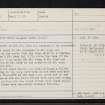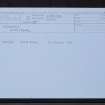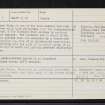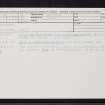Longmanhill, Longman Cairn
Long Cairn (Neolithic)
Site Name Longmanhill, Longman Cairn
Classification Long Cairn (Neolithic)
Alternative Name(s) Langman Cairn; Longman Hill
Canmore ID 19290
Site Number NJ76SW 1
NGR NJ 7377 6200
Datum OSGB36 - NGR
Permalink http://canmore.org.uk/site/19290
- Council Aberdeenshire
- Parish Gamrie
- Former Region Grampian
- Former District Banff And Buchan
- Former County Banffshire
NJ76SW 1 7377 6200.
(NJ 7377 6200) Longman Cairn (NR)
OS 6" map, Banffshire, 2nd ed., (1904)
The cairn is 220ft long and appears to be composed of a round cairn 70ft diameter 14ft high and separated on the south from the long cairn by a trench-like hollow 5ft deep 150ft long, 9ft high and varying from 40ft wide at the north to 25ft wide at the south end.
The whole seems fairly complete although a hollow has been dug in the long part both on the west and east sides. On 18 September 1886 at the west ie south end of the long barrow an urn was found filled with calcined bones; on 5 February 1888 another urn was found filled with black mould. Evidently these were secondary cinerary burials.
A Chalmers 1898.
Longman Cairn is one of the four eastern Scottish long barrows which have affinities with the characteristic burial mound of the Windmill Hill culture in southern and eastern England. The northern end is about 14ft high and is divided from the remainder by a transverse hollow, possibly the site of an un-recorded excavation. Modern quarrying into the side of the mound shows it to be built mainly of earth and probing detected relatively few stones.
S Piggott (ed.) 1962.
This grass-covered barrow is as described.
Revised at 1/2500.
Visited by OS (EGC) 24 September 1963.
Longman Cairn: Generally as previously described; there is little doubt that both parts of the barrow belong to one structure.
A S Henshall 1963.
No change.
Visited by OS (RL) 25 January 1968.
The monument is a well-preserved long earthen burial mound; it is about 66m long in total and appears to comprise a large round mound (c. 22m across and 4m high) with a long tail to the SSW. Slight damage has been done to the area at the N by quarrying, and a smaller hole was dug into the S end in the 1950s. The main part of the monument survives intact, however.
Information from Historic Scotland, scheduling document dated 28 February 1997.














